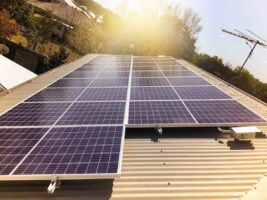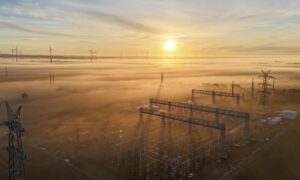Western Australia’s Garden Island Microgrid – a cornerstone project for wave power developer Carnegie Clean Energy – has officially powered up, and is producing green electricity for Australia’s largest naval base, HMAS Stirling.
Carnegie says the microgrid’s 2MW of solar and 2MW/0.5MWh battery storage system have formally commenced operations, after getting final all-clear from the Department of Defence.
The news marks a positive step forward on the road to recovery for Carnegie, which was went into voluntary administration in March of this year.
Carnegie has been in collaboration with WA network operator Western Power on the Garden Island microgrid project since 2015, with intention of building it around the company’s CETO 6 wave power generation technology.
Garden Island, off Perth, is where the company first tested an array of CETO 5 generators, back at the beginning of 2015, sending wave-generated electricity into the local grid, and kicking off grand plans to commercialise its technology and specialise in island-based microgrids.
But an ill-fated acquisition of micro-grid specialist Energy Made Clean, and the last-minute termination of a $16 million W.A. government contract to build a 20MW wave farm off the coast of Albany, helped bring those plans undone.
Now, having offloaded the subsidiary EMC, and served its time in administration, Carnegie is getting back on track, with a $5.5 million recapitalisation round and fresh plans to deliver a commercial ready version of its CETO wave energy technology.
A statement from Carnegie last week said that integrating wave generation at Garden Island remained a key part of the plan for the microgrid, of which it would retain 100 per cent ownership, following recapitalisation.
“The system is designed as a wave-integrated microgrid and the agreements with the Department of Defence include the ability to sell power produced from wave energy,” the statement said.
“Over the coming months, Carnegie will be working to optimise the system including ramping up capacity and system functionality,” it said.
At a webinar to support the company’s recapitalisation, Carnegie CEO Jonathan Fiévez said the balance sheet and cash-flow forecast for the new-look Carnegie was far simpler than ever before.
“We don’t have the large projects with large capital expenditure, penalty clauses and other liabilities that were so hard to predict,” he said.
Fiévez said the CETO IP remained the company’s “most valuable asset,” despite the write downs that had occurred over the years.
The Garden Island microgrid was named as the “second most significant asset,” with a valuation of more than $4 million at the time of the last audit.
“It’s a revenue producing asset and a key footprint on Garden Island, providing an option for us to deploy there again,” Fiévez said.









